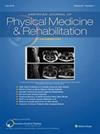超声与电刺激诊断神经阻滞在痉挛中有针对性的肌肉选择。
IF 2.4
4区 医学
Q1 REHABILITATION
American Journal of Physical Medicine & Rehabilitation
Pub Date : 2021-11-01
DOI:10.1097/PHM.0000000000001801
引用次数: 0
摘要
本文章由计算机程序翻译,如有差异,请以英文原文为准。
Ultrasound With E-Stimulation Diagnostic Nerve Blocks for Targeted Muscle Selection in Spasticity.
T he diagnostic nerve block has been used to assist in the evaluation of a muscle’s contribution to spasticity for decades. The diagnostic nerve block is helpful to evaluate the range of motion to determine whether a true muscle contracture is present as opposed to a reducible deformity and to evaluate the strength of antagonist muscles when the muscle is paralyzed and range of motion increases because of a cessation of the spastic muscle overactivity. The French Clinical Guidelines, published in 2019, describe the techniques in detail and note that there is insufficient evidence for the superiority of ultrasound (US) over e-stimulation with surface localization alone. Ultrasound allows for direct nerve and vascular identification. The combination of US and e-stimulation aids in localization of a targeted nerve with a reduced volume required of phenol. The complex but readily identifiable fascicular branching of nerves and their relationship to the neurovascular bundle is demonstrated in a detailed study of the branches of the tibial nerve. The diagnostic nerve block offers much information to the clinician. It may demonstrate which muscle is the main contributor to a spastic overactive pattern, such as differentiating the elbow flexor muscles or the muscles responsible for the spastic equinovarus foot. After identifying a targeted muscle that is most responsible for the spastic overactive positioning, it can aid in guiding therapy with botulinum toxin, phenol and alcohol, surgical neurectomy, or a mini-invasive percutaneous neurotomy. The addition of US allows for the direct visualization of blood vessels, thus reducing the chance of injury. The key vascular structures importantly serve as a beacon for landmarking. As a color Doppler feature is ubiquitous onmost USmachines, the localization is easily confirmed in real time. Not only does color Doppler reduce chance of puncture, the well-known mantra of vein-artery-nerve serves to identify that key nerve branches will be located as they course around the vascular structures. We have provided a video vignette that demonstrates how this intimate relationship of nerves and their fascicles to vascular structures allows for rapid recognition of the targeted nerve upon ultrasound scanning. We demonstrate some of the most common nerves targeted in spasticity management: obturator, femoral, lateral pectoral, musculocutaneous, and the tibial nerve fascicular branches. Our technique illustrates how the color feature allows for localization of the guiding blood vessels, which can be seen to pulsate even without color. The US also allows for demonstration that the needle can be placed at the desired nerve without the trial-and-error placement and replacement of e-stimulation alone. Furthermore, US visualization ensures that only the desired nerve branch to a targeted muscle is stimulated. Finally, we demonstrate the use of a cryoneurotomy probe for targeted localization of the tibial nerve branches to the gastrocnemius and tibialis posterior muscles, which requires sustained contact to the nerve.
求助全文
通过发布文献求助,成功后即可免费获取论文全文。
去求助
来源期刊
CiteScore
4.60
自引率
6.70%
发文量
423
审稿时长
1 months
期刊介绍:
American Journal of Physical Medicine & Rehabilitation focuses on the practice, research and educational aspects of physical medicine and rehabilitation. Monthly issues keep physiatrists up-to-date on the optimal functional restoration of patients with disabilities, physical treatment of neuromuscular impairments, the development of new rehabilitative technologies, and the use of electrodiagnostic studies. The Journal publishes cutting-edge basic and clinical research, clinical case reports and in-depth topical reviews of interest to rehabilitation professionals.
Topics include prevention, diagnosis, treatment, and rehabilitation of musculoskeletal conditions, brain injury, spinal cord injury, cardiopulmonary disease, trauma, acute and chronic pain, amputation, prosthetics and orthotics, mobility, gait, and pediatrics as well as areas related to education and administration. Other important areas of interest include cancer rehabilitation, aging, and exercise. The Journal has recently published a series of articles on the topic of outcomes research. This well-established journal is the official scholarly publication of the Association of Academic Physiatrists (AAP).

 求助内容:
求助内容: 应助结果提醒方式:
应助结果提醒方式:


